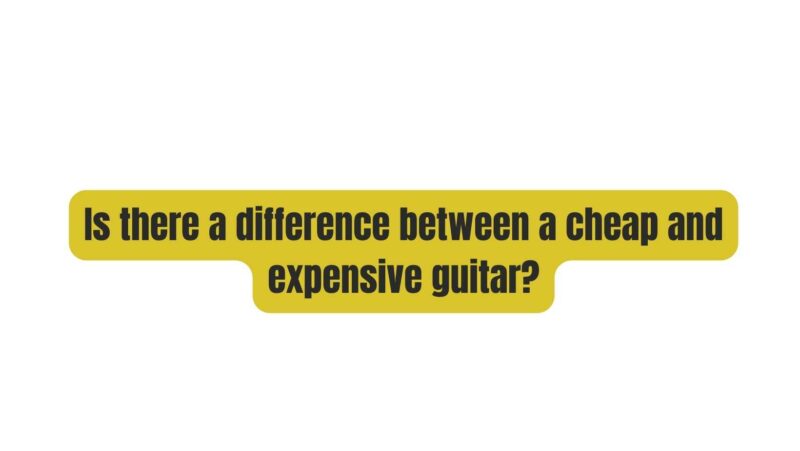Guitars, with their captivating melodies and profound ability to evoke emotions, hold a special place in the hearts of musicians and enthusiasts. When embarking on the journey of choosing a guitar, one of the fundamental considerations is whether to opt for a budget-friendly model or invest in an expensive one. The question that often lingers is, “Is there a real difference between a cheap and an expensive guitar?” In this article, we’ll dissect the nuances and unveil the disparities between these two categories of guitars, offering valuable insights for players of all levels.
I. The Price Spectrum: Navigating Guitar Costs
Before we delve into the differences, it’s essential to understand the price spectrum of guitars:
- Budget-Friendly Guitars (Under $300): These guitars are accessible to beginners and cost-conscious players. They are designed for entry-level musicians.
- Mid-Range Guitars ($300 to $1000): Mid-range guitars strike a balance between affordability and quality. They cater to a diverse range of players, from intermediates to enthusiasts seeking excellent value for money.
- Premium Guitars ($1000 and Above): Premium guitars are characterized by exceptional craftsmanship, top-quality materials, and advanced features. They are often chosen by professional musicians and serious enthusiasts.
II. Materials and Build Quality
One of the most apparent differences between cheap and expensive guitars is the quality of materials and construction:
- Tonewoods: Expensive guitars typically use higher-grade tonewoods, including solid woods like Sitka spruce, mahogany, and rosewood. These tonewoods contribute to better resonance, sustain, and tonal quality.
- Laminates vs. Solid Wood: Budget guitars often use laminated wood for the top, back, and sides, while premium guitars usually feature solid wood construction. Solid wood offers superior sound characteristics.
- Hardware: Expensive guitars come with better hardware components, such as tuners, bridges, and pickups. These components enhance tuning stability, intonation, and overall playability.
- Craftsmanship: Premium guitars are crafted with meticulous attention to detail and quality control. The level of craftsmanship in an expensive guitar is often far superior, resulting in better playability and aesthetics.
III. Sound Quality and Playability
The differences in materials and build quality directly impact the sound and playability of the guitar:
- Sound: Expensive guitars generally produce a more refined, nuanced, and expressive tone with greater clarity and sustain compared to their budget counterparts. This difference is especially noticeable in acoustic guitars.
- Playability: The setup, action (string height from the fretboard), and fretwork of an expensive guitar are often more precise. This translates to smoother playability, reduced fret buzz, and greater ease of playing.
IV. Versatility and Features
Higher-priced guitars often offer more versatility and additional features:
- Tonewood Varieties: Premium guitars may provide a wider range of tonewood options, allowing players to choose the sound characteristics that align with their preferences.
- Pickup Configurations: Electric guitars in the premium category often offer more diverse pickup configurations, enabling players to explore a broader sonic palette.
- Built-In Electronics: Acoustic-electric guitars in the premium range frequently include high-quality built-in electronics for amplification and recording, enhancing their versatility.
V. Durability and Longevity
Premium guitars are often constructed to withstand the rigors of regular playing and are expected to perform reliably over the years. They typically offer:
- Construction Quality: High-end guitars are built with durability in mind, ensuring they can withstand the demands of professional use and touring.
- Quality Control: Premium guitars undergo rigorous quality control processes, reducing the likelihood of issues that may arise in lower-priced instruments.
VI. Resale Value and Investment
Higher-priced guitars tend to retain their value better over time, making them potentially better investments for resale in the future. Conversely, budget guitars may depreciate more quickly.
VII. Conclusion: The Guitar’s Journey
In conclusion, the differences between cheap and expensive guitars are not merely a matter of price; they encompass a spectrum of factors that impact sound, playability, and overall performance. While budget-friendly guitars provide accessible entry points for beginners and cost-conscious players, premium guitars offer superior materials, craftsmanship, and tonal characteristics.
The choice between these two categories depends on your individual needs, aspirations, and budget. Budget guitars are suitable for those exploring their interest or seeking an affordable option. However, if you are committed to advancing your skills, exploring diverse musical styles, and seeking a more rewarding playing experience, investing in an expensive guitar can be a wise choice.
Ultimately, the guitar is more than just an instrument; it is a vessel for creativity, self-expression, and connection to the universal language of music. Whether you begin with a budget guitar or ascend to a premium model, your guitar journey is a unique and personal one, marked by the joy and inspiration derived from playing this timeless instrument.

